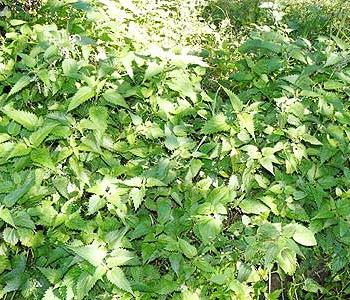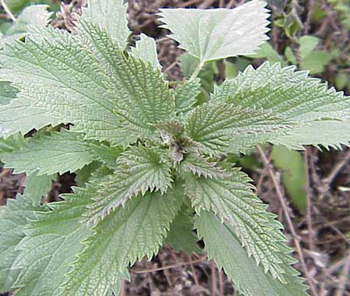Contents:
Common Names | Parts Usually Used | Plant(s) & Culture | Where Found | Medicinal Properties | Biochemical Information
Legends, Myths and Stories | Uses | Formulas or Dosages | Nutrient Content | How Sold | Warning | Resource Links | Bibliography
Scientific Names

- Urtica dioica L.
- Uricaceae
- Nettle family
Common Names
- Chinese nettle
- Common nettle
- Common stinging nettle
- Great nettle
- Great stinging nettle
- Hsieh-tzu-ts’ao
- Stinging nettle
Parts Usually Used
Whole plant
Back to Top

Description of Plant(s) and Culture
A most potent herb, the many qualities compensating for the stung fingers that inevitably accompany the harvest. The sting is caused by the formic acid in the plant and can be soothed by rubbing the spot with dock leaves (Rumex obtusifolus). Providence, somehow, usually plants the dock alongside the nettle beds. Nettle is like a beast with a heart of gold.
Nettle is a perennial
Varieties: Urtica gracilis Ait.; Urticastrum
The plant
Back to Top
Where Found
Found on waste land, vacant lots, pastures and in hedges, nettles can be found in plenty. Found all over the world.
Back to Top
Medicinal Properties
Astringent, hemostatic, diuretic, galactagogue (promotes flow of milk), lowers blood sugar levels, expectorant, tonic, nutritive, styptic, rubefacient
Back to Top
Biochemical Information
Formic acid, silicon, potassium, tannins, glucoquinones, histamine, acerylocholine, serotonin, chlorophyll, carbonic acid, mucilage, magnesium, iron, many minerals and
Back to Top
Legends, Myths and Stories
Nine of the 30 species of Urtica are found in the United States and Canada growing wild.
It is an old English custom to drink nettle tea on occasion. This habit was believed to have been brought with the Roman conquerors to the Isles, who used the tea as a bracer in the rigorous climate.
Nettle is often an ingredient in herbal prescriptions. The addition of nettle leaves to Oriental tea in a proportion of
A novel use of the nettle plant was as a counter-irritant in rheumatic cases. The afflicted person was “whipped” on the rheumatic joint with whole plants. The idea was that the pain of nettle stings would make the sufferer forget the pain of the rheumatism.
Caesar’s troops introduced the Roman nettle
Nettle rash can be relieved by applying the juice of the leaves themselves, thus taking away the stinging of the nettles.
It is said that if hens are given dry nettles in the winter, broken in small pieces, with their food, they will fatten and increase egg production all winter long. When nettle is cut and allowed to wilt, used as fodder for livestock, it is said to increase the amount of milk produced. In Germany, dried nettle is mixed with feed for thin horses suffering digestive troubles. Horse dealers mixed the nettle seed with oats and other feeds to give the animals a sleek coat. In Egypt, oil from the nettle seeds is used in burning lamps.
The Russians make a beautiful green dye for woolens from the nettle plant. The root boiled with alum makes a yellow dye. The tall stalks yield a stronger and finer fiber than flax. The Germans used this in place of cotton in World War II.
According to an old recipe book, steel dipped in the juice of the nettle becomes flexible.
Back to Top
Uses
Nettle is widely used to treat rheumatism and poor circulation, but also cures bronchitis, prevents scurvy, reduces the risk of hemorrhage, neuralgia, scrofula, sore throat, sore mouth, sciatica, vaginal yeast infections, anemia, increases milk flow for nursing mothers, lowers blood sugar, joint aches, neuralgia, gout, first stages of dropsy, bee stings, whooping cough, expel worms, and dispels melancholia.
The leaves may be boiled and then eaten like any green vegetable, or else used for an infusion. A decoction may also be made from the root, this is good for dissolving renal (kidney) stones and other internal obstructions. Old herbals say that nettles are useful in weight-reducing diets. Treats tuberculosis, anemia, clorosis, rickets, scrofula, lymphatic problems. A good spring tonic. Boiled leaves applied externally will stop bleeding almost immediately. Externally applied for eczema.
A tincture made of the seeds is recommended for goiter and low thyroid. In raising the thyroid function, it effectively reduces the associated obesity.
The warm tea is used for asthma, hay fever, allergies, colds, fever, grippe, flu, mucous condition of the lungs, pleurisy, leprosy, diarrhea, cholecystitis, dysentery, hemorrhoids, various hemorrhages, scorbutic affections, and mucous in the colon in adults.
Boiling the entire plant in a mixture of vinegar and water, then adding eau de cologne was supposed to produce a good hair lotion. Combing the hair with expressed nettle juice was supposed to stimulate hair growth, bring back the natural color of the hair. Or dip fingers in and thoroughly massage the scalp and it will cure dandruff.
Pulped nettle leaves make a marvelous compress and bring cooling relief when inflammation is present.
Back to Top
Formulas or Dosages
Infusion: steep
Juice: mix with an equal amount of water and take
Extract: mix
Scalp wash: boiled
Back to Top
Nutrient Content
Vitamins A and C, magnesium and iron
Back to Top
How Sold
Capsules: take
Back to Top
Warning
Do not eat uncooked plants, especially old plants uncooked; they can produce kidney damage and symptoms of poisoning.
Handle the plants with care.
The bristly hairs of the nettle plant act like a tiny hypodermic needles, injecting an irritant substance under the skin when touched: handle with care.
Back to Top
Resource Links
Cancer Treatment that ‘Reboots’ Itself, Thanks to This Herb
Bibliography
![]() The Herb Book
The Herb Book, by John Lust, Bantam Books, 666 Fifth Avenue, New York, NY. copyright 1974.
![]() Eastern/Central Medicinal Plants
Eastern/Central Medicinal Plants, by Steven Foster and James A. Duke., Houghton Mifflin Company, 215 Park Avenue South, New York, NY 10000
![]() Back to Eden
Back to Eden, by Jethro Kloss; Back to Eden Publishing Co., Loma Linda, CA 92354, Original copyright 1939, revised edition 1994
![]() Culpeper’s Complete Herbal & English Physician: Updated With 117 Modern Herbs
Culpeper’s Complete Herbal & English Physician: Updated With 117 Modern Herbs, by Nicholas Culpeper, Meyerbooks, publisher, PO Box 427, Glenwood, Illinois 60425, 1990, (reprint of 1814)
![]() The Complete Medicinal Herbal
The Complete Medicinal Herbal, by Penelope Ody, Dorling Kindersley, Inc, 232 Madison Avenue, New York, NY 10016, First American Edition, copyright 1993
![]() The Herbalist Almanac
The Herbalist Almanac, by Clarence Meyer, Meyerbooks, publisher, PO Box 427, Glenwood, Illinois 60425, copyright 1988, fifth printing, 1994
 Old Ways Rediscovered
Old Ways Rediscovered, by Clarence Meyer, Meyerbooks, publisher, PO Box 427, Glenwood, Illinois 60425, published from 1954, print 1988
![]() Indian Herbalogy of North America
Indian Herbalogy of North America, by Alma R. Hutchens, Shambala Publications, Inc., Horticultural Hall, 300 Massachusetts Avenue, Boston, Massachusetts 02115, 1973
 Earl Mindell’s Herb Bible
Earl Mindell’s Herb Bible, by Earl Mindell, R.Ph., Ph.D., Simon & Schuster/Fireside, Rockefeller Center 1230 Avenue of the Americas, New York, New York 10020
 Secrets of the Chinese Herbalists
Secrets of the Chinese Herbalists, by Richard Lucas, Parker Publishing Company, Inc., West Nyack, NY, 1987.
![]() Culpeper’s Complete Herbal & English Physician: Updated With 117 Modern Herbs
Culpeper’s Complete Herbal & English Physician: Updated With 117 Modern Herbs, by Nicholas Culpeper, Meyerbooks, publisher, PO Box 427, Glenwood, Illinois 60425, 1990, (reprint of 1814)
Herbal Gardening, compiled by The Robison York State Herb Garden, Cornell Plantations, Matthaei Botanical Gardens of the University of Michigan, University of California Botanical Garden, Berkeley., Pantheon Books, Knopf Publishing Group, New York, 1994, first edition
 The Magic of Herbs
The Magic of Herbs, by David Conway, published by Jonathan Cape, Thirty Bedford Square, London, England. (Out of print)
![]() The Nature Doctor: A Manual of Traditional and Complementary Medicine
The Nature Doctor: A Manual of Traditional and Complementary Medicine, by Dr. H.C.A. Vogel; Keats Publishing, Inc., 27 Pine Street (Box 876) New Canaan, CT. 06840-0876. Copyright Verlag A. Vogel, Teufen (AR) Switzerland 1952, 1991
![]() Planetary Herbology
Planetary Herbology, by Michael Tierra, C.A., N.D., O.M.D., Lotus Press, PO Box 325, Twin Lakes. WI 53181., Copyright 1988, published 1992
![]() American Folk Medicine
American Folk Medicine, by Clarence Meyer, Meyerbooks, publisher, PO Box 427, Glenwood, Illinois 60425, 1973
![]() The Yoga of Herbs: An Ayurvedic Guide to Herbal Medicine
The Yoga of Herbs: An Ayurvedic Guide to Herbal Medicine, by Dr. David Frawley & Dr. Vasant Lad, Lotus Press, Twin Lakes, Wisconsin, Second edition, 1988.
 Taber’s Cyclopedic Medical Dictionary
Taber’s Cyclopedic Medical Dictionary, 15th Edition, F. A. Davis Company, 1915 Arch Street, Philadelphia, PA 19103
![]() Webster’s New World Dictionary
Webster’s New World Dictionary, Third College Edition, Victoria Neufeldt, Editor in Chief, New World Dictionaries: A Division of Simon & Schuster, Inc., 15 Columbus Circle, New York, NY 10023
 How Indians Use Wild Plants for Food, Medicine & Crafts
How Indians Use Wild Plants for Food, Medicine & Crafts, by Frances Densmore, Dover Publications, Inc., 180 Varick Street, New York, NY 10014, first printed by the United States Government Printing Office, Washington, in 1928, this Dover edition 1974
 An Instant Guide to Medicinal Plants
An Instant Guide to Medicinal Plants, by Pamela Forey and Ruth Lindsay, Crescent Books (January 27, 1992).
 The Rodale Herb Book: How to Use, Grow, and Buy Nature’s Miracle Plants (An Organic gardening and farming book)
The Rodale Herb Book: How to Use, Grow, and Buy Nature’s Miracle Plants (An Organic gardening and farming book), edited by William H. Hylton, Rodale Press, Inc. Emmaus, PA, 18049., 1974
